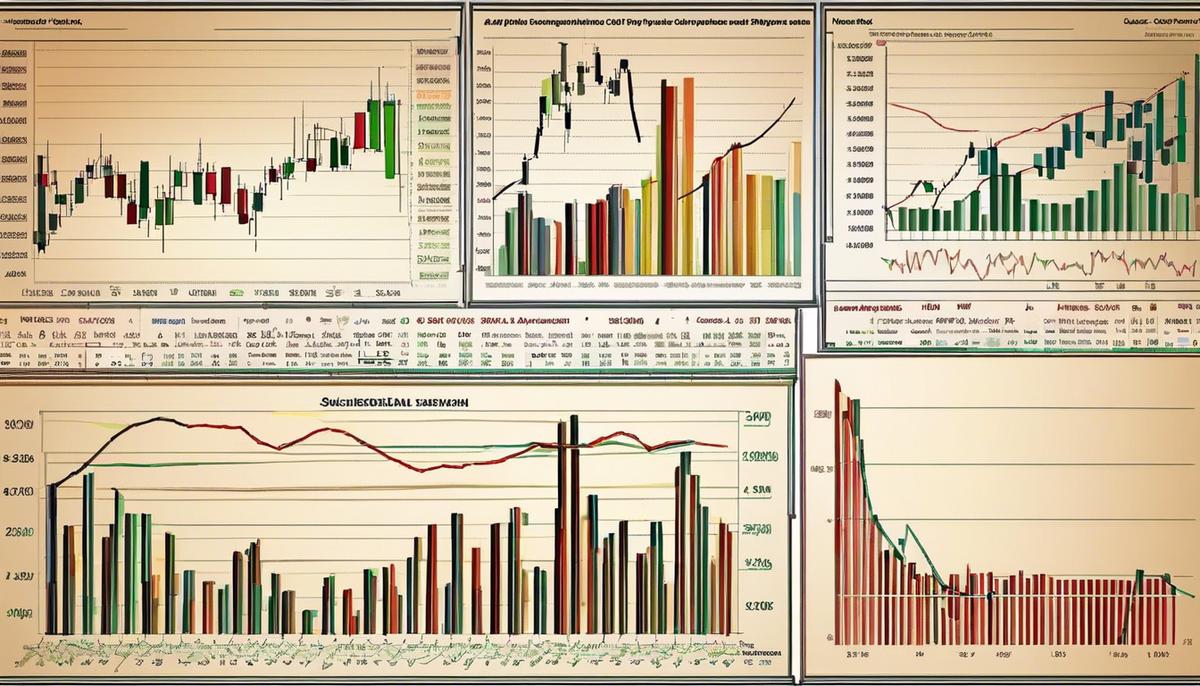If you’re interested in making informed investment decisions, gaining a comprehensive understanding of stock market trends is crucial. This involves not only familiarizing yourself with the fundamental stock market terminologies such as shares, dividends, bear and bull markets, and so forth, but also learning how to interpret stock charts to identify trends and forecasts. Moreover, acknowledging the influence of macro and micro-economic factors on stock prices offers investors an edge in predicting future market trends. Whether you’re an experienced investor or a beginner in the market, these tools can act as your compass in navigating the often unpredictable currents of stock trading.
Understanding Basic Stock Market Concepts
Unraveling the Essentials: Stock Market Concepts Every Savvy Biz Whiz Must Absorb
The arena of stock market investing; a roaring playground for the intellectually zealous, the calculative minds, and the ambitious entities with an appetite for risk. Navigating the stock market labyrinth successfully necessitates an understanding of foundational concepts – the key to unlocking the strategic advantage!
- Stocks and Shares: The Fundamentals
- Market Capitalization: Sizing Up Companies
- IPOs: A Trailblazing Start on Wall Street
- Bull Vs. Bear Markets: The Mood Meter
- Dividends: The Harvest of Investment
- P/E Ratio: The Value Estimator
At its core, the stock market is a marketplace. Businesses offer shares, or portions of their company, to the public. Acquiring these shares signifies holding a fragment of the company, turning you into a part-owner. In exchange, these businesses acquire capital to propel their plans – building factories, expanding product lines, or innovating next-gen technologies. It’s a Tit-for-Tat dance between businesses and investors.
Market capitalization (Market Cap, for the abbreviation-savvy), defines the total value of all outstanding shares of a company. It’s the pulse that reveals the company’s size and its perceived public worth. Simply calculate the current market price per share and multiply it by the total number of outstanding shares. Understanding Market Cap offers investors invaluable knowledge in diversifying investment portfolios and managing risk.
IPO, an acronym for Initial Public Offering, represents a company’s foray into the stock market. In an IPO, companies sell their shares to public investors for the first time. These new options often stoke the flames of investor curiosity and enthusiasm, making IPOs a hotbed for potential opportunity.
Bull markets represent optimism and investor confidence as stock prices ascend. Conversely, bear markets symbolize pessimism with falling stock prices – the yin and yang of the stock market world. Identifying these market trends can equip you to pivot your investment strategies, playing the game with finesse.
Dividends are typically a portion of a company’s profit that’s distributed to its shareholders. It’s consistent gratification for investors, serving as a token of your persistent faith in the company and its growth. Remember, a high-dividend yield can tantalize, but scrutiny must never waver. Dive into the company’s financial health.
The Price-to-Earnings (P/E) ratio, often pegged as the “price multiple,” defines the amount an investor is willing to shell out for each dollar of the company’s earnings. It’s a crucial indicator of how the market perceives the stock’s potential future growth. Lower P/E ratios may signal undervalued stocks while higher values might hint at overvaluation. It’s the X-ray vision investors need to discern between bargain and expensive stocks.
The stock market’s complexity teases and tantalizes, challenging the bold. Yet, fostering a robust understanding of these core concepts de-mystifies its intricacies, empowering you to participate, innovate, and diversify with more precision and less uncertainty. The prospective entrepreneur’s guide to thriving within a market both volatile and vibrant!

Learning How to Read Stock Charts
Perfecting your Investment Strategy: Here’s How to Interpret Stock Charts
Utilizing stock charts is an integral part of any successful investment strategy. By correctly interpreting these visual representations, a wealth of data is at your fingertips, ready to guide your investment decisions. This article is the stock chart decoding manual you’ve been seeking.
Types of Stock Charts
Before diving into specifics let’s clarify the most common types of stock charts:
- Line charts
- Bar charts
- Candlestick charts
- Point and figure charts
Each chart type presents data in a unique way to cater to different trading strategies. Let’s unpack each type one by one.
Line Charts
Creating a line chart means we’re connecting closing prices over a chosen time period. A glance presents the general price movement of the stock. Bear in mind, this simplicity equates to a loss of detailed information such as intraday prices.
Bar Charts
Bar charts are more comprehensive. Each bar displays the opening price, the closing price, the highest price, and the lowest price during that period. This data helps investors understand the turbulence of a stock’s price within the time frame. It allows room for deeper analysis.
Candlestick Charts
Originating in the 18th century, Japanese rice traders first used candlestick charts. These charts are stylized with a thick “body” signifying the range between the opening and the closing price, and thin “wicks” indicating the highest and lowest prices of the period. The body’s color, often black or white, designates whether the closing price was lower or higher than the opening. Because of their detailed visualization, they are highly favored by technical analysts.
Point and Figure Charts
Compared to the aforementioned trio, point and figure charts disregard time consistency. This type is completely price-driven, documenting only when the price changes. This method reduces noise from minor price fluctuations and emphasizes significant trends.
How to Interpret the Information?
Once you understand the types of charts, the next step is to interpret the patterns within the data. Many investors follow patterns termed as ‘bullish’ or ‘bearish’, indicating the potential for a rising or falling market respectively. Look for patterns such as ‘head and shoulders’, ‘cup and handle’, ‘double tops and bottoms’, and ‘triangles’. Each of these patterns suggests either a continuation of the trend or a reversal.
Furthermore, don’t forget to incorporate other trading indicators like Moving Average lines or Bollinger Bands that can add an extra layer to the chart, providing added insight into potential market moves.
Remember, the art and science of reading stock charts hinge on your ability to interpret them. Tracking company data, keeping up to date with industry trends, understanding global economic dynamics, all provide context to the here-and-now of the numbers. Don’t simply react to the patterns in the charts, but understand them in the context of the wider financial world.
In conclusion, interpreting stock charts is a coveted skill that can be substantially profitable when mastered. It’s a tool, and like any other, its effectiveness ultimately depends on the one who wields it. So take this knowledge, investor, and yield the fruits from Wall Street’s ever-moving tree.

Analyzing Macro and Micro Economic Factors
The Importance of Economic Indicators in Stock Market Predictions
Understanding the role of macro and micro economic factors in the forecasting of stock market trends holds paramount importance for astute investors. This critical knowledge can mean the difference between capitalizing on market opportunities and missing out on potential growth. Let’s delve into the indispensable insight that economic indicators provide, and how that translates to predicting stock market trends.
Macro Factors: The Bigger Picture
Macro economic factors, the larger economic indicators that paint the broad-stroke picture of a country’s economy are crucial to discerning potential movements in the stock market. Factors such as GDP changes, fiscal policy, unemployment rates, and inflation among others, directly reflect the health of a nation’s economy.
A dip or rise in these indicators could signify a potential bear or bull market. For instance, strong GDP growth or low unemployment rates typically stimulate confidence in the economy leading to a bullish market, as investors expect corporate performance to improve. Conversely, poor GDP growth, high inflation, or rising unemployment rates can trigger a bearish market, causing a slippery slide in stock prices.
Micro Factors: Details that Count
Micro economic factors, on the other hand, focus on individual sectors or industries. These include company earnings reports, industry trends, CEO changes, product launches, and M&A activity. These indicators can forecast the performance of specific company stocks. A surprisingly positive earnings report or the launch of an industry-changing product can have an immediate uptick on that company’s stock. Conversely, negative news can quickly diminish a company’s market capitalization.
The trend is not entirely dependent upon these factors alone but combined with macro indicators, can effectively influence the direction of stock market trends.
The Interplay
The real magic happens when macro and micro indicators are analyzed together, offering valuable predictive insights. For instance, strong macroeconomic data in a thriving industry could potentially boost the stocks of companies within that sector. Similarly, a company surpassing estimates in a downtrodden industry could signal a buying opportunity, offering high rewards for those ready to act.
In conclusion, the ability to balance and understand macro and microeconomics in the ever-evolving business landscape dictates the success of investing maneuvers. The intricacies of these economic indicators cannot be understated, and therefore, mastering this understanding is pivotal to predicting stock market trends, safeguarding an investor’s portfolio, and ensuring healthy returns.

As you increase your financial literacy and skill set, you’ll find that interpreting stock market trends becomes less of a mystery and more of a strategic calculation. Familiarizing yourself with basic market lingo, understanding how to read different chart types, and recognizing the influence of economic indicators on share prices are all fundamental building blocks of savvy investing. Such knowledge increases your foresight and prepares you for the roller coaster ride of investing. With these tools at your disposal, you can confidently make investment choices that align with your financial goals and risk tolerance.



